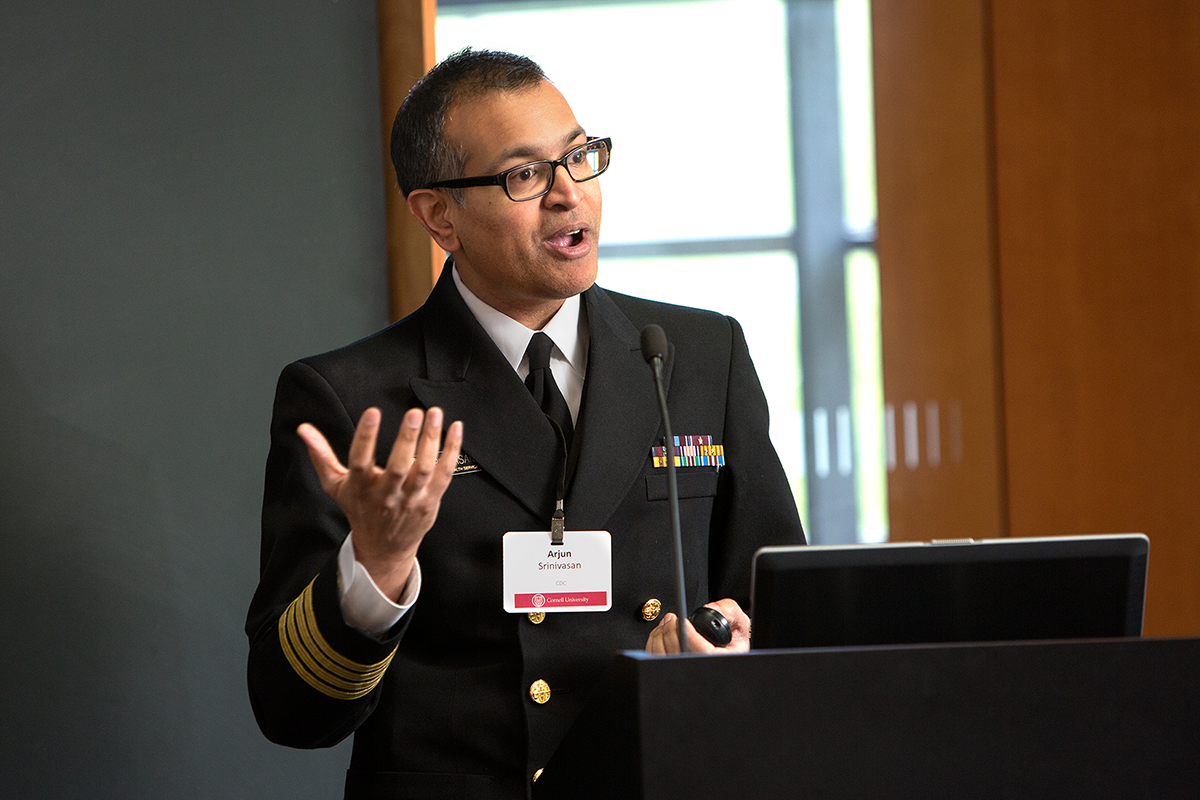Symposium examines threat of antimicrobial resistance
By Krishna Ramanujan

“There are times when transmissible diseases can actually be so serious that they can threaten the very security of the nation or the world. [Antimicrobial resistance] has been classified as a problem that reaches that level,” said Dr. Arjun Srinivasan, associate director of Healthcare Associated Infection Prevention Programs at the Center for Disease Control and Prevention (CDC).
Srinivasan delivered a keynote address on the threat of rising resistance by infectious microbes to antibiotics in animals and humans during a symposium on Cornell’s Ithaca campus May 4. The symposium, “Antimicrobial Resistance: Research Synergies in Human and Animal Medicine,” featured presentations by Cornell and other experts from diverse veterinary, medical and biological backgrounds, while also creating opportunities to network and collaborate on this issue.
“If you’ve been following the news media at all, antimicrobial resistance is a worldwide health challenge both for animal and human health and at Cornell we have a unique opportunity to bring people together across the spectrum of different disciplines to address the problem,” said Lorin Warnick, the Austin O. Hooey Dean of the College of Veterinary Medicine.
The CDC defines antimicrobial resistance “as something that is resistant to the first line of recommended therapy,” said Srinivasan. An estimated 2 million resistant infections are diagnosed annually in the U.S., resulting in 23,000 deaths per year, he said.
Microbes classified as urgent threats include carbapenem-resistant Enterobacteriaceae (CRE), drug-resistant Neisseria gonorrhoeae and clostridium bacilli, though the list of infectious agents is dynamic, with the possibility of new resistant pathogens developing at any time, he said.
He emphasized the interdependency between humans and animals. A study of chickens on a Boston-area farm found that within one week of giving tetracycline antibiotics in feed, a common agricultural practice, “intestinal flora of the chickens contained almost completely tetracycline-resistant organisms,” Srinivasan said. Further investigation into people who worked or lived on the farm and their neighbors revealed that the closer people lived to the farm, the more they were colonized with these tetracycline-resistant organisms.
Though the U.S. quit using colistin – “the antibiotic of last resort” – in humans long ago as less toxic options arose, it is now being increasingly used in people in the U.S. to treat resistant infections, such as CRE, he said. “Pathogens that are resistant to colistin are pretty much untreatable,” he said.
Colistin is used in agriculture in many countries, and colistin-resistant bacteria in food-producing animals do transfer to people and are spread globally, Srinivasan said.
Since 2014, investments by the federal government to combat antimicrobial resistance have led to a national strategic action plan targeting five key areas: slowing development of antimicrobial-resistant bacteria and stopping their spread; implementing better surveillance strategies; developing faster diagnostics; researching and developing new antibiotics, therapies and vaccines; and cooperating internationally.
To slow the development of resistant bacteria, doctors, farmers and veterinarians must become judicious about administering antibiotics, Srinivasan said. In humans, doctors must reduce “just-in-case” prescribing, as antibiotics are often prescribed for noninfectious, nonbacterial syndromes or for positive culture results even though a patient has no symptoms.
“In humans, about one-third of all antibiotic use is deemed to be unnecessary,” Srinivasan said.
In animals, herd metaphylaxis – medicating an entire herd or a portion of a herd to prevent or minimize the impact of an infectious disease – and antibiotic prescriptions to companion animals are two areas for improvement. Data show that improving antibiotic use alone can “slow development of resistance, and we might even be able to reverse it,” he said.
The CDC has begun educating people and implementing antibiotic steward programs and policies to guide the way antibiotics are used in hospitals, nursing homes, outpatient clinics and on farms.
We also need better data, testing and surveillance, Srinivasan said.
“We don’t have good enough data for where resistance is occurring, what resistance is occurring, what the mechanisms of that resistance are. The longer it takes to detect resistance, the longer it takes to respond to that resistance,” he said.
An Israeli strategy to contain an outbreak of CRE that began in 2005 included a national effort using best practices, better surveillance and communication between health care facilities. This effort led to a drop in CRE cases by 80 percent and offers a model the CDC is now adopting.
And, “one of the things we have to do is what you are doing here today” by bringing together experts from diverse fields to share knowledge, Srinivasan said.
The symposium, which promoted a One Health philosophy that recognizes the interconnectedness of human, animal and environmental health, was sponsored by Cornell’s College of Veterinary Medicine, Weill Cornell Medicine, the Office of the Vice Provost for Research and the American Society for Microbiology.
Media Contact
Get Cornell news delivered right to your inbox.
Subscribe